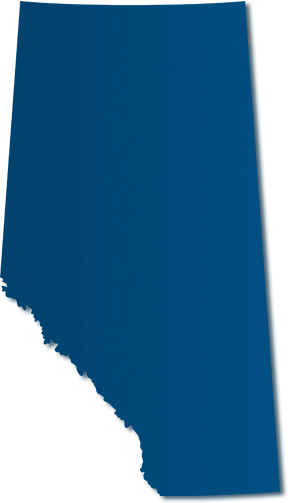Spring 2015 (Volume 25, Number 1)
History of Rheumatology in
Southern Alberta
By J. Paul Ryan, MD, FRCPC
Download PDF

In the fall of 1883, Canada was a young nation and the Canadian Pacific Railway (CPR) arrived in the Bow Valley, west of Calgary. That winter, three men employed by CPR stayed and “discovered” the thermal springs. For many years the local First Nations’ peoples knew of the thermal springs and had used them to treat their aches and pains. Because of the potential of these springs and the surrounding mountains, the Canadian government established the first national park in 1887, later to be known as Banff National Park.
The first physician in Banff was Dr. R.G. Brett (1851-1921). He was sent to Banff in 1886 by the CPR to look after the medical problems of the local population. To capitalize on the thermal springs, he quickly established the Brett Sanitarium (equal parts bar, poolroom, hotel, and hospital). The building is still in use as the current headquarters for the Banff Parks Administration. In 1904, Dr. Brett built the Brett Hospital, which was later named the Banff Mineral Spring Hospital. The water from the mineral springs was piped down the mountain to the hospital as well as the newly built Banff Springs Hotel. Patients came to Banff from all over North America to try this thermal (spa) therapy for their arthritis.
.jpg)
Banff Mineral Springs Hospital, circa 1930. Courtesy of the Whyte Museum of the Canadian Rockies. V469. 1780. George Noble Fonds.
In 1925, Dr. Dean Robinson joined Dr. Harry Brett (son of Dr. R.G. Brett) in Banff to look after patients with arthritis. Dr. Robinson went to Europe in 1930 seeking new knowledge and treatment for these patients. Upon his return, he initiated the first hospital program treating patients with arthritis using exercises, rest, casting, and gold injections, in addition to thermal therapy. He was the first to publish a paper in Canada describing the treatment of more than 100 patients using two forms of gold injections. In 1950, he was one of the first to use and report on the side effects of adrenocorticotropic hormone (ACTH) and cortisol in the treatment of arthritis. In most of his publications Dr. Robinson ended the paper by a political plea for increased funding for treatment of patients with arthritis (sound familiar?).
Dr. Robinson was one of the founding members of the Canadian Rheumatic Disease Association (CRDA), along with a number of other physicians in eastern Canada. During the Second World War, this organization was not very active. After the war, however, it was renamed the Canadian Rheumatism Association (CRA) at a meeting at the newly renovated Banff Springs Hotel.
Dr. Robinson encouraged a number of Banff patients to form an arthritis club. This group, along with others in Vancouver, petitioned the government to support the treatment of patients with arthritis. Because of this lobby, a conference was called in 1947 and the Canadian Arthritis and Rheumatism Society (CARS) was formed. Dr. Dean Robinson was the father of Dr. Harold Robinson, who later became one of the Rheumatic Disease Unit (RDU) heads in Vancouver.
Calgary now became the centre of rheumatic disease treatment. At the encouragement of Edward Dunlop, Dr. D. G. (Red) Howard trained as a rheumatologist. After his training he returned to Calgary to set up a rheumatology practise in 1954. In the early 1960s, the convalescent and rehabilitation wing was built at the Calgary General Hospital and 30 beds were designated for rheumatology patients.
In 1966, the Faculty of Medicine was created at the University of Calgary, with the first medical students being admitted in 1970. The RDU of the University of Calgary was formally established at the General Hospital in 1973 with Dr. Howard as the first Head. To complement Dr. Howard,
Dr. Martin Atkinson was recruited to join him at the Calgary General Hospital.
The next head of the Calgary RDU, from 1975 to 1985, was Dr. Doug Kinsella, whose research interest was sero-negative arthritis. His successor, Dr. Marvin Fritzler, was keenly involved in researching autoimmune diseases and serology. With Dr. Fritzler as Head, the RDU moved from the General Hospital to the University of Calgary and the Foothills Hospital. Dr. Atkinson remained as the clinical director at the Calgary General Hospital.
Under the leadership of Dr. Fritzler, the Arthritis Chair was established. The first individual to occupy this chair was Dr. Mark Adams, whose research focused on osteoarthritis. By now the Calgary RDU was well established, boasting research, resident training, and patient care.
From its humble beginnings in Banff, we now have 25 rheumatologists (both adult and pediatric) practicing in Calgary.
J. Paul Ryan, MD, FRCPC
Clinical Associate Professor,
Cumming School of Medicine,
University of Calgary
Calgary, Alberta
.jpg)
Bathing at the Mineral Hot Springs, circa 1930. Courtesy of the Whyte Museum of the Canadian Rockies. V263/NA. 5968. Byron Harmon Fonds.
|



